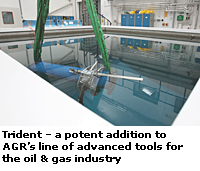AGR Field Operations introduces technology that makes 3D inspection of subsea pipelines simple and affordable
20/04/2010
 A new state-of-the-art diver-operated subsea inspection system from AGR Field Operations is said to make the inspection of pipelines better, simpler, more effective and more affordable than it is at present. The tool, named Trident, is a potent addition to AGR Field Operations' line of advanced tools for the oil and gas industry.
A new state-of-the-art diver-operated subsea inspection system from AGR Field Operations is said to make the inspection of pipelines better, simpler, more effective and more affordable than it is at present. The tool, named Trident, is a potent addition to AGR Field Operations' line of advanced tools for the oil and gas industry.Trident is one metre in length, has zero buoyancy in water and is easy to connect on to pipelines. The tool's ultrasonic probes map pipeline base material and pipe welds across a range of pipe diameters and data is transmitted through an umbilical to the surface, where engineers can examine the 3D data. The technology allows for real-time analysis and decision making.
Trident is particularly suitable for shallower scopes of work, where divers are already in service performing planned IRM activities. It has been designed for use in the air and saturation diving range to a depth of 300 m.
Trident's most promising markets are in the UK, the Middle East, Asia and the Americas. These areas have offshore activity in relatively shallow waters, making divers a natural choice over ROVs for subsea work. In addition, the areas have thousands of kilometres of piping that are approaching the end of their intended life spans, where it is believed that what Trident has to offer will be of interest. Fracture mechanics calculations and probabilistic remaining life assessments can be significantly improved using actual empirical data collected by Trident.
The new Trident technology is introduced to expand the existing range of inspection tools. In shallow waters, where the AGR Field Operations' existing Neptune ROV inspection unit is not being used because of rough currents, the Trident will be providing valuable inspection information. The phased array technology will now be integrated into the Neptune system that will allow phased array ROV deployment down to a depth of 300 m.
"Trident basically lets us take the way we work on land to a subsea environment," says Executive Vice President of AGR Field Operations, Åge Landro.